Force DISKPART to delete EFI system partition in Windows 11 and 10
So you've upgraded your Windows laptop by replacing its old mechanical spinning disk hard drive with a fast SSD. Congratulations, your laptop is much faster now. What to do with the old drive though? Sure it's not fast, but it probably still has a few years of useful life in it, wouldn't it be nice to repurpose it for use as a backup drive? So you are going ahead and trying to erase the old data from it, but you encounter a problem: Windows refuses to remove the old EFI system partition ![]() that used to have Windows boot files on it. Sound familiar? This article should explain how to delete the EFI partition and erase the whole hard drive properly.
that used to have Windows boot files on it. Sound familiar? This article should explain how to delete the EFI partition and erase the whole hard drive properly.
Windows offers a built-in tool for working with storage devices, Disk Management. You can run it by right-clicking on Windows 11/10 Start button and choosing Disk Management from the popup menu:
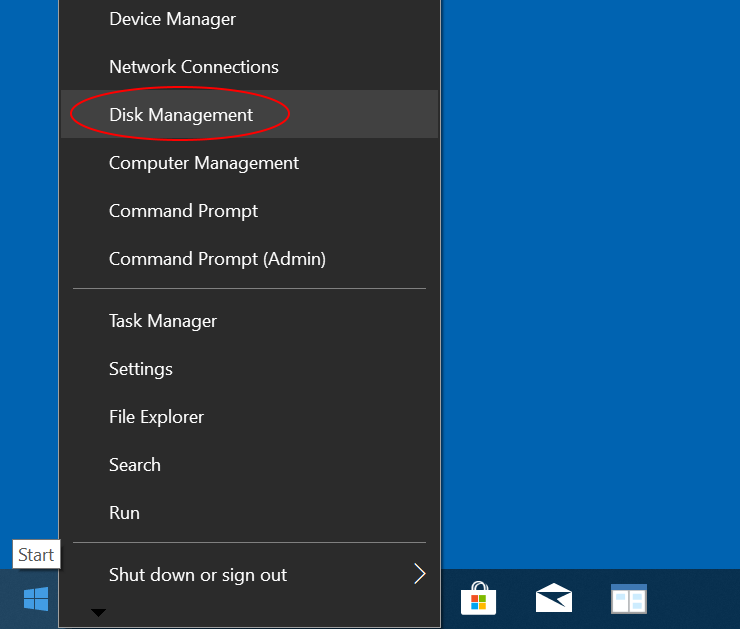
(If you use an older version of Windows such as Windows 7, you can get to this tool by right-clicking the My Computer item on Start menu and choosing Manage from the popup menu.)
If you used this tool before, you probably know that its screen is split horizontally. The top half lists volumes and their respective drive letters, while the bottom half contains a list of the storage devices currently attached to the computer and available for use by Windows. If the old hard drive that you want to erase is connected to the computer, you should find it in the bottom part of the screen.
(Note that if you've just cloned the old hard drive to the SSD and both are attached, then Windows may keep one of them offline. If this happens to you, simply force Windows to bring the hard drive online.)

Now back to erasing the old hard drive. First of all, make sure you recognize the drive you want to erase in the list: you don't want to accidentally erase a wrong drive. Scroll through the list in the bottom part of the Disk Management window and make sure you can identify each disk listed there: which one is the primary boot drive (usually it's the first one), which one is the CD/DVD drive, and which one represents the drive you want to erase. If in doubt, disconnect the drive from the computer and refresh the list, notice which entry would disappear. Now attach the drive back to the computer and see its entry reappearing back in the list. If you are confident which entry represents the drive you want to erase, go on.
Take a note of the disk number that Windows assigned to the hard drive you want to work with. In our example above, the disk number is 2. We will need it later on.
To remove old information from the drive, use Disk Management to delete the partitions this drive contains. Right-click each partition and choose Delete Volume from the menu:
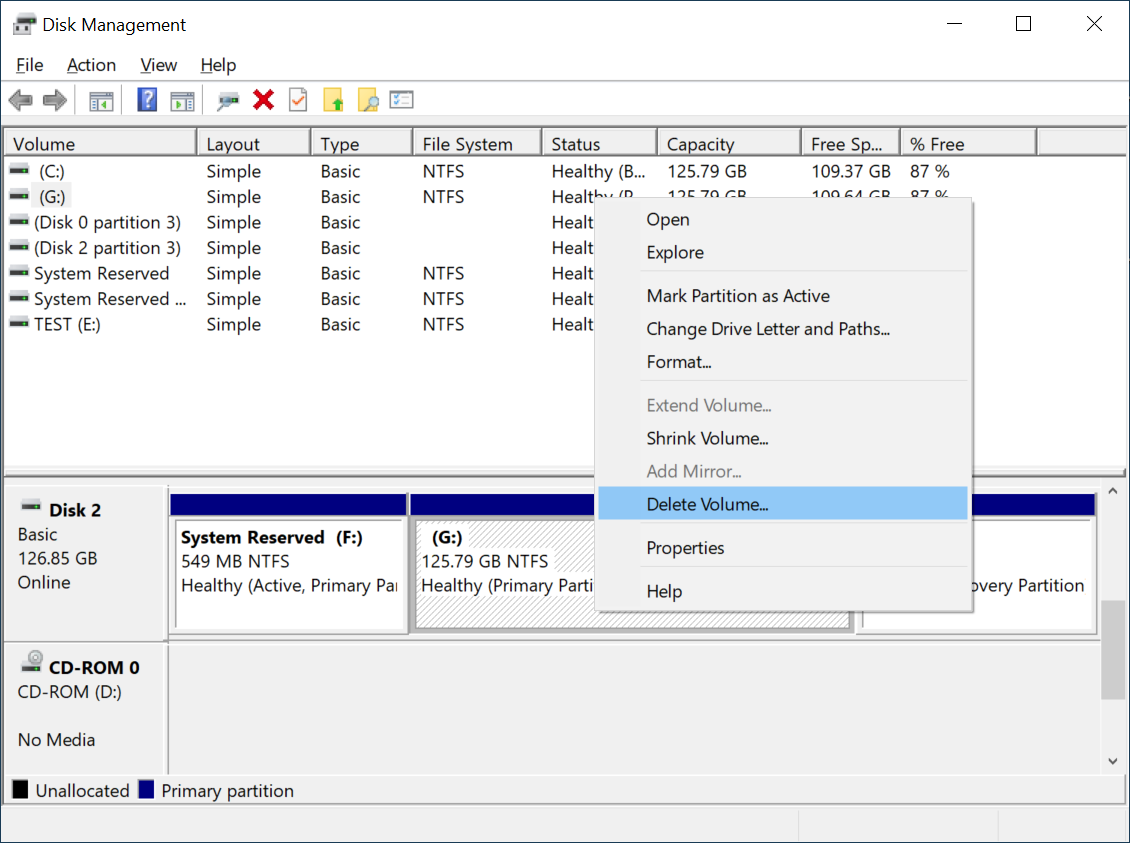
This should work on most partitions, but if the hard drive was previously used for a Windows installation, then it may contain one or two system partitions that cannot be deleted this way: when you right-click on such a partition, the popup menu does not have the Delete Volume command!
To erase the disk in such a situation, we must bring heavy artillery: the command prompt. Run the command prompt As Administrator. (If it's not on the right-click menu of the Start button, you should find it under the Windows System group on Start menu.) Now recall that the disk we want to erase was listed as Disk 2 in the Disk Management list. Enter the following commands into the command prompt to erase it:
diskpart
list disk
select disk 2
clean
exit
Before issuing the clean command, double check the list of the disks displayed and make sure you have selected the correct disk number. This is the point of no return: once the clean command is finished, all data and all partitions are deleted from the selected drive. If you have selected a wrond drive, there is no easy way to recover its data after the clean command.
While you are issuing the commands, the command prompt window should look similar to the following:
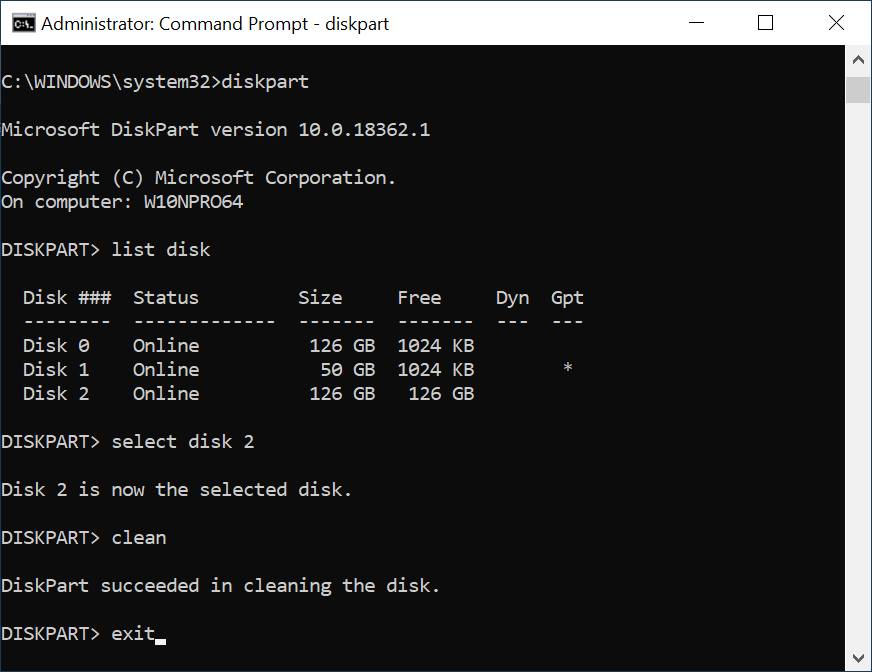
The next step in the rejuvenation of the old hard disk is to initialize it. While the disk you've just cleaned is still connected to the computer, run Disk Management again, and it should prompt you to initialize the disk automatically:
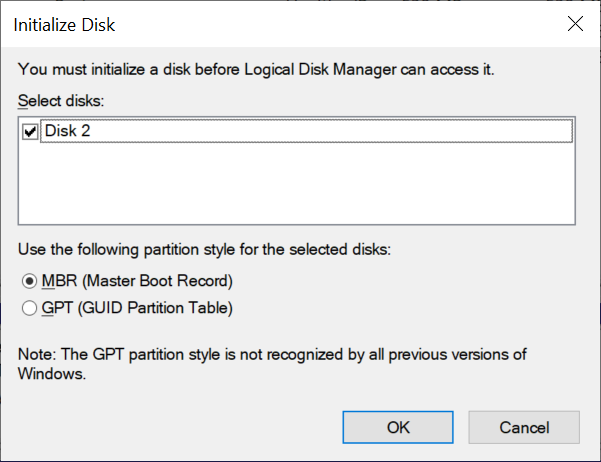
Which option to choose, MBR or GPT? This question deserves a separate article, but for now the rule of thumb is: if the disk size is less than 2TB, it's OK to choose MBR. For larger disks, choose GPT.
The final step is to create a volume on the freshly initialized disk and format it. You can do it all within the Disk Management screen, by right-clicking on the Disk 2 entry and using the New Simple Volume command on the shortcut menu:
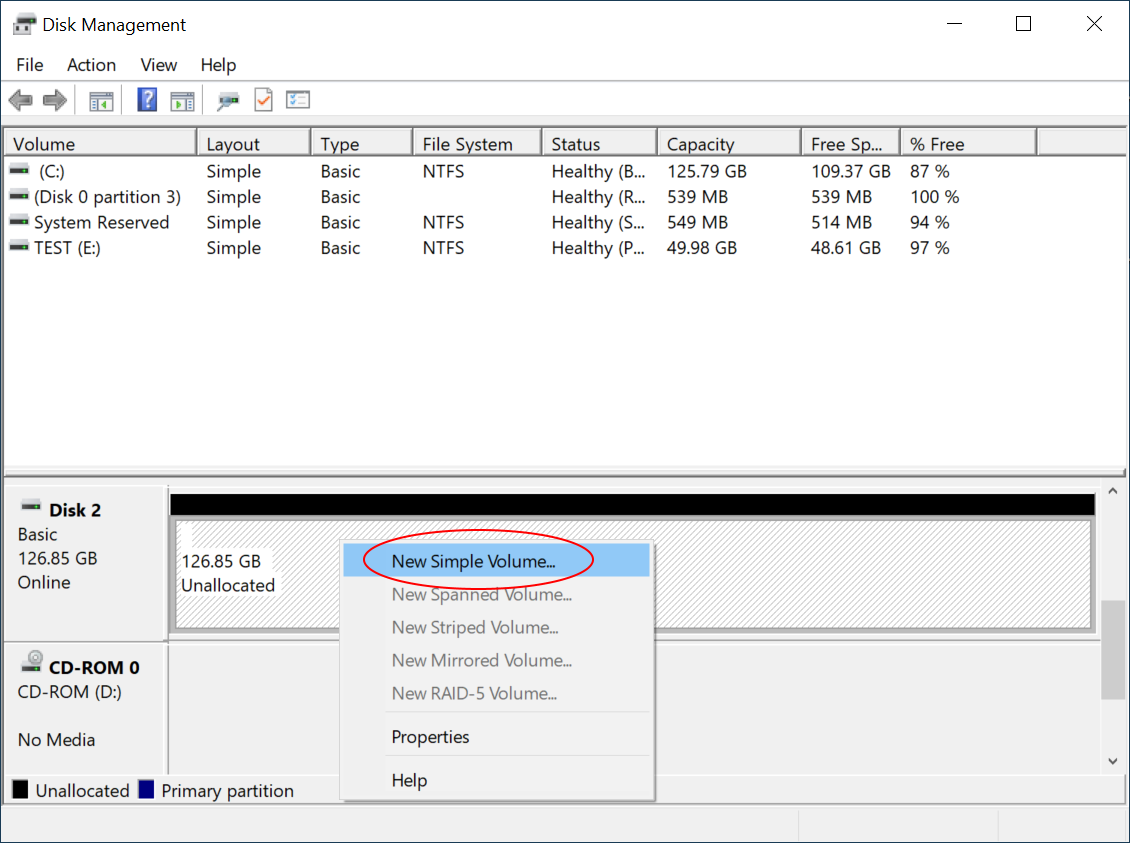
After the last step is done, close Disk Management, and look inside the This PC folder: your newly refreshed old hard drive should appear there, with its own drive letter, ready for use.
Happy disk managing!
If you want to link to this article, you can use this HTML code: <a href="https://www.winability.com/force-diskpart-delete-remove-efi-system-partition-windows-10/">Force DISKPART to delete EFI system partition in Windows 11 and 10</a>
Read more
- How to disable Adobe's ability to scan all of your organization's documents for generative AI.
- How to send sensitive files using Password.File app.
- [SOLVED] How to disable Taskbar Thumbnail Preview in Windows 11.
- How to restrict access to Microsoft Store app with Folder Guard.
- Tired of the Your password has expired and must be changed prompts? Here is how to stop them.
- How to move Pictures and other folders to Virtual Encrypted Disk.
- How to disable Fast Startup if you use encryption software.
- How to restore Videos, Pictures, and other folders in This PC in Windows 11.
- How to create a local user account in Windows 11 or Windows 10.
- How to enable or disable test signing mode in Windows.
- Email or SMS text messaging are NOT secure for two-factor authentication.
- Estimate how much you could save on electric bill with ActiveExit software.
- How to delete partition on Windows 11 or Windows 10.
- Forget VeraCrypt password? Here is how to recover it.
- Why do my desktop icons keep moving?
- How to create a private folder in Windows 11 and 10.
- How to restrict access to Windows Settings with Folder Guard.
 Suspending all contact with fascist Russia
Suspending all contact with fascist Russia- How to keep desktop icons from moving by running Icon Shepherd from command line.
- How to restrict access to Task Manager with Folder Guard.
- Take ownership of your files after access denied due to NTFS permissions.
- How to reprogram or disable CAPS LOCK key.
- Encryptability vs Folder Guard: which one to choose?
- Troubleshooting software removal problems using MSI files.
- Encryptability: Compare Personal and Business Licenses.
- How to add Group Policy and Local Security Policy to Windows 11 and 10 Home edition.
- [SOLVED] File is too large for the destination file system.
- Forget your WI-FI password? Find it in Windows 11 and 10 settings.
- What is FAT32 maximum file size limit?
- How to create a secret folder in Windows 11 and 10.
- How to easily password-protect Windows Linux folders with Folder Guard.
- Force DISKPART to delete EFI system partition in Windows 11 and 10.
- How to make Windows 11 and 10 recognize a cloned hard drive again.
- How to stop Windows 11 and 10 from using thumbnail preview icons for folders.
- How to hide pictures from the Photos app in Windows 11 and 10.
- How to save Windows Spotlight photos to your computer.
- How to move the OneDrive folder to an encrypted drive.
- Windows 10 fails to upgrade? Here is how to fix it.
- How to stop Microsoft Edge from opening PDF files.
- Preventing installations of specific programs with Folder Guard.
- Folder Guard licensing explained.
- Speed up the updates of the network folders.
- Make your Windows laptop work as a Wi-Fi access point.
- How to stop automatic Windows Update in Windows 10 and 11.
- [SOLVED] Windows cannot connect to the printer. Access is denied.
- Migrating encrypted data from TrueCrypt to USBCrypt.
- “The Microsoft account service is unavailable right now. Try again later.”
- Using DiffMerge as the external tool of AB Commander to compare plain text files.
- How to repair the icon cache and/or thumbnail cache in Windows 11 and 10.
- Transferring images between your PC and an Android device: Part 2.
- Transferring images between your PC and an Android device: Part 1.
- Case study: Using SoftDetective to suppress Corel Guide sign-in prompt.
- Using junction points to change the iTunes backup folder location.
- How to tell if my Windows computer is 32- or 64-bit?
- How do I stop Windows from rearranging my desktop icons?
- Organize your photo library with the Rename tool of AB Commander.
- Windows does not offer the NTFS format option? Here is how to bring it back.
- How to encrypt Firefox profile, bookmarks, and cookies.
- Restarting Windows 11, 10, and Windows 8 in the safe mode.
- Integrating AB Commander with Universal Viewer.
- How to delete a protected EFI system partition with Windows 11,10, 8, or 7.
- Using Folder Guard to protect from the social engineering attacks.
- How to erase Windows login password if you forget it.
- How to unhide a folder hidden with Folder Guard.
- How to repair Windows desktop icons with AB Commander.
- Slow network in Windows 7 Virtual PC? Speed it up!
- How to show drive letters first in AB Commander and Windows Explorer.
- What is my IP address?
- Why can’t I copy large files over 4GB to my USB flash drive or SD card?
- Test the strength of your password with USBCrypt.
- How to set up an external text editor for AB Commander.
- How to restrict Internet Explorer from downloading programs from the Internet.
- Personal vs business license for USBCrypt.
- Use Folder Guard to restrict access to Control Panel.
- Compare MySecretFolder and Folder Guard.
- Hide folders and make files invisible with Folder Guard.
- WINEXIT vs ActiveExit: automatically log off users from Windows.
- How to protect folder with password in Windows 11 and 10.
- How to restrict access and lock external drives with Folder Guard.
- How to password-protect Dropbox folder with USBCrypt.
- How to set up Folder Guard to stop downloading from the Internet.
- Is (Wipe the content) the same as (Secure Delete)?
- How to encrypt and protect the system C: drive with USBCrypt.
- Make it easier to return your lost encrypted drive.
- USBCrypt for users of Microsoft Office.
- How to start programs elevated from a batch file.
- How to make elevated programs recognize network drives.
- How to disable or enable hibernation.
- Using names and labels to organize USBCrypt drives.
- How to password-protect a USB flash drive.
- Always have a backup of your important files.
 Stand with Ukraine
Stand with Ukraine

